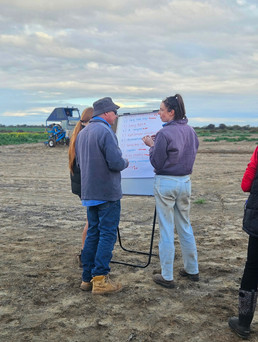Trials and Torchlight at The Liebe Group’s Post-Seeding Field Walk
- Liebe Group

- Jul 9, 2025
- 2 min read

By Amber Martin
From late-sown crops to glowing fertiliser under torchlight, this year’s Post-Seeding Field Walk offered valuable insights, genuine discussion, and a great chance to check in with how early-season trials are shaping up.
Held on Wednesday 2nd July at the Nugadong Main Trial Site, the afternoon gave attendees a guided look at several of the Liebe Group’s 2025 trials. The program featured long coleoptile wheat, canola establishment, cereal post-emergent scorch, and late sowing options—each one prompting valuable paddock discussions and timely takeaways for the season ahead.
There was strong interest across all trials, with attendees sharing observations and experiences as they moved through the rotation. The scorch plots provided a look at a range of post-em chemical mixes, helping growers weigh up risks and rewards when it comes to post-em weed control. It was noted that while scorch was visible, the scorch from most mixes was considered acceptable—especially if they hit the weed target. The canola establishment trial also drew attention, offering a visual comparison of sowing depths and prompting discussion on establishment variability across the site.
The long coleoptile wheat trial was a standout, with deeper-sown plots emerging later but quickly catching up—demonstrating the potential of long coleoptile varieties to chase moisture and support early vigour. Conversations covered nutrient placement, internodal root development, and the possibility of deeper sowing helping crops get ahead of soil-borne disease pressure.
The late-sown crop demonstration was similarly well received. This trial sparked discussion around the economics of seeding into June, with growers questioning whether a late crop was worthwhile, or if alternative strategies like fallow or deep ripping might deliver a better return.
The day finished with a crowd-pleasing dye night facilitated by CSBP, where fertiliser was coated in a fluorescent dye, making it possible to see its placement in the furrow using torches in the dark. This hands-on session showed how different fertiliser strategies stack up, with plenty of curiosity (and torch beams) focused on where nutrients actually end up in the furrow.
A sundowner and BBQ followed, giving everyone a chance to debrief, share ideas, and enjoy a relaxed evening together, finishing up a productive and enjoyable afternoon in the field.
A big thank you to all attendees, presenters and partners who made the day possible. We look forward to seeing how the season unfolds from here.




























































